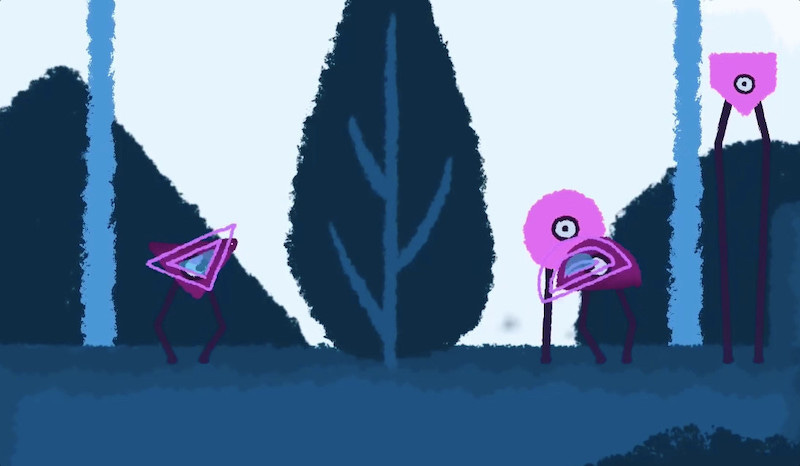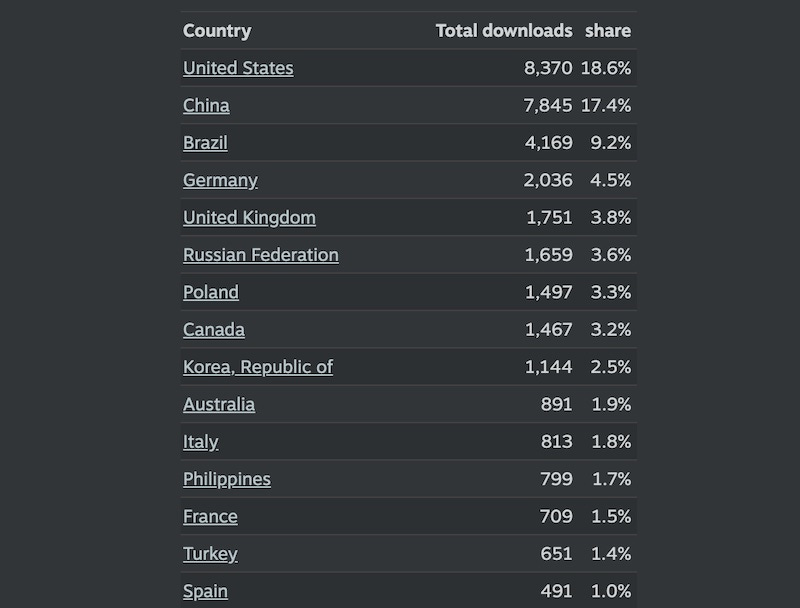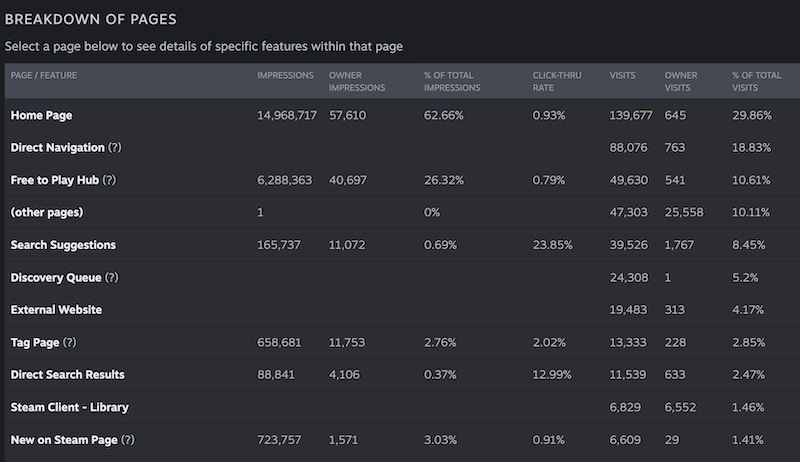How 'hook' made With You stand out as a free Steam game
It's not all about $$$, you know.
[The GameDiscoverCo game discovery newsletter is written by ‘how people find your game’ expert & GameDiscoverCo founder Simon Carless, and is a regular look at how people discover and buy video games in the 2020s.]
Welcome back to a new week for the ever eclectic GameDiscoverCo newsletter, folks. Upcoming in the next few issues, we have an interview with a VC, our VR survey results, and multiple pieces on the Game Pass-ization of premium singleplayer games - if that’s really a thing. (Is it? It is. Is it?)
But this time, we look behind the scenes on a short, free Steam game to examine its metrics and how it got to where it currently is. (Which is ‘lots of people playing it’, spoiler alert.) Let’s check it out…
[ALERT: only three days left to get 22% off our GameDiscoverCo Plus subscription, thanks to that ‘2/2/22’-spawned deal. Extra perks include an exclusive weekly PC/console game market analysis, a Plus Discord, a Steam data back-end, game discovery eBooks & more.]
With You - lessons from a viral Steam free game?
So most of the time, the GameDiscoverCo newsletter is concerned with, well, discovery and monetization. Making money is important to many of you. But I think it’s also important to note that anyone can make and release games on PCs. And sometimes we can learn discovery and ‘hook’ lessons from short free titles that go a little bit viral.
And in recent days, Carol Mertz’s co-operative “two-player puzzle playground” With You, originally created a couple of years back as part of her MFA degree at New York University, is one of those. (Nowadays Carol works as a senior game designer at card/board game company Exploding Kittens, who also understand hook extremely well. Cos, y’know, exploding kittens?)
She told us: “I'd actually considered releasing [the game] only on itch.io, but decided to eat the $100 Steam fee only so that folks could play online using Remote Play Together.” And look at the impressive results in the 2+ weeks since release, following the game’s appearance in Steam’s New & Trending chart:
A lot of people work hard on games for years, and only have a few thousand folks play them. So 97,000 ‘add to library’ Steam actions and 49,000 unique players in just a couple of weeks is great going. (Median time played is 10 minutes - because the game is intentionally tiny, by the way. Oh, and there’s been 17,000 Remote Play sessions.)
Carol did concede that “there is a huge amount of privilege to being able to release a free, no-strings-attached game on a platform like Steam - I'm a salaried game designer, so I don't need income from side-projects like this.” But we shouldn’t ignore the fact that tens of thousands wanted to download and play this. Why? Here’s our Q&A to work out how the Snipperclips-esque co-op game went big & show related stats:
Q: It seems to me that With You is a game with a really good 'hook'. And I love talking about hooks. What do you think the hook is that's leading people to play it? What do they see at a brief glance that convinces them to check it out?
At a glance, I think the handmade art style and limited color palette is attractive to a lot of casual players. The colors, art, and logo are very soft, which stands out in the crowd on a storefront like Steam. And then when you read the short description and see that it's a game specifically designed for couples to play together, I think that's where it resonates - nonviolent co-op games for dates are, in my experience, really hard to find. Ultimately, I think that With You is a tiny game filling a very big void on Steam.
Q: I agree. I also think the game is very visually ‘readable’ as a cool, abstract cartoon-y game where you collaborate with someone else. So for me, ‘visually attractive and understandable, co-op, short, and free’ is the magic discovery mix here! What are some of the best and most heartwarming pieces of feedback or reviews you've seen for the game so far?
My cousin, who is not a traditional gamer, played with her partner, who is a regular Steam user. She said they had a great time and that, while she was concerned that it would be too difficult for her as a non-gamer, she had no problem playing. That is the exact use-case I was designing around - folks with deep game literacy introducing cooperative play to their partners, who may not have much experience with videogames.
For With You, I conscientiously designed a casual, approachable game for couples with differing levels of game literacy so that they could play together for perhaps the first time. Some other reviewers on Steam echo that sentiment, and it's really rewarding to know that I've created something that encourages people to share their hobby with someone they love.
Q: Do you get the sense that most of the interest in the game has come from Steam's recommendations itself, due to the free/short nature of the game and its prominent featuring? (The name of the game makes it incredibly un-Google-able, haha.)
Ha! Yes, I have a bad habit of making games with un-Google-able titles. What I know about traffic is that the morning after launch, I got an email from someone who works for the Opera GX web browser saying they found my game and had featured it in their browser showcase of free games for the week.
I think that drove some important early traffic, because Day 1 traffic was very slow, and after that it started to snowball with New & Trending features on Steam, starting in the Free Games section and branching out from there. Once it hit the front page, it got featured in Destructoid, IndieGamesPlus, and GamingOnLinux. Here’s the country breakdown for lifetime downloads:
Q: Thanks for also providing a breakdown of how ‘impressions’ (appearances of your game elsewhere on Steam) led to page visits, which is always interesting. Looks like the home page (thx to New & Trending?) and the Free To Play hub were two major sources of traffic:
Continuing, you noted on Twitter after the game blew up: "I have, as one might expect, gotten some harassment over the last few days for releasing a game like this." That sucks.
It does suck. It's incredibly disappointing, but unfortunately unsurprising. I think that there are a lot of men who feel threatened by the idea of softness, vulnerability, and intimacy - the fact that a game that so unapologetically encourages all of those things appeared on the front page of Steam sets them off. It's like if Taylor Swift was a surprise headliner at a heavy metal festival or something.
All that said, I don't generally respond to harassment other than flagging egregious reviews for abuse (that Steam later unflags anyway), but it definitely echoes around in my head more than I'd like. I won't get too far into the mental health impacts of it all, but there were a few moments when I regretted releasing it on Steam. I really wish we could do better as an industry when it comes to community management and moderation.
Q: We like talking about ‘hook’ here - so a final question about your physical game Hellcouch, which I had fun playing in the alt.ctrl.GDC festival a couple of years back. I feel like that game has a great hook, too. Can you talk briefly about why you made it and why you thought that particular idea could be resonant?
I was studying at the NYU Game Center at the time, and had fallen in love with microcontrollers and alternative gameplay hardware. I said to my classmate, "What if we make a couch co-op game where the couch is the controller?" And that was the hook that drove us to develop Hellcouch.
We went through several iterations of gameplay concepts, but landed on the simplest we could, which was ultimately a "Simon Says" sit-down-stand-up sort of game. Similarly to With You, it was simple and approachable to folks who didn't understand games (it was just sitting on a sofa, after all), but unique and exciting to folks who do (it's sitting on a sofa to control a game!).
I definitely think there's a huge sweet spot there, in merging something new and interesting with simplicity and familiarity. Plus, the humor of the Hellcouch theme certainly helped - who doesn't want to use their butt to exorcize a demon from a sofa?
[Thanks again for the interview, Carol. This is a slightly different one for us - since the game has zero revenue and doesn’t have commercial intent. But there are things to learn here about hook, virality and conceptually interesting games - and we’re passing them right along.]
Trending Quest games show VR’s new push!
We’ve been talking about VR games more often than normal recently, thanks to the recent success of the Meta Quest 2. We had this market overview from Cassia Curran, and Wednesday’s newsletter will be led by our VR survey results.
So while researching the space, we spotted that RoadToVR has a monthly Quest store ‘charts’ piece which includes the most popular paid apps, as monitored from mid-January 2022 to mid-February 2022. And since we’re estimating that each additional store rating is (very roughly!) just over 100 game purchases, here’s what impressed us:
We’ve talked about VR MMO Zenith: The Last City in our Plus newsletters with regards to its well-received Steam version, where it looks to have sold 100-150k units. But with 4,579 ratings total on Quest, it may have crested 500,000 units sold on that platform - in about a month*! Wow. (*Guesstimate based on data we’ll be showing on Wednesday.)
There are definitely other familiar titles in the countdown, including the Five Nights At Freddy’s VR title, Resident Evil 4, Beat Saber, and so on. Also interesting to see Blade & Sorcery - a big VR hit on PC - come to Quest with its special ‘Nomad’ version and burn through perhaps 200k sales for the last month, and 1 million plus since its November 2021 debut.
Finally, you’re continuing to see a lot of casual sports game - American football, boxing and table tennis among them in this chart - move extremely impressive units on Quest 2. There’s room for ‘core’ experiences in VR, but also more casual games along the lines of Wii Sports (and the upcoming Switch Sports!)
It continues to be a bit of a surprise to us that Quest VR sales have blown up this much, this quickly. (Previous VR iterations that were tethered or PC-connected felt way more core gamer-centric, whereas the Quest 2 feels impressively self-contained.)
But when you have an excited audience of nearly 15 million players, a parent company pushing Superbowl ads, and everyone has had a few years practice making VR games - the ecosystem can become quite tempting for developers and publishers alike.
The game discovery news round-up..
Finishing up for today, it’s time to wander through the large amount of new game discovery and platform news, and lay it out for your delight and delectation. And here we go:
Just started today is the February 2022 Steam Next Fest, of course, featuring hundreds of demos of upcoming Steam games. As well as a ‘Recommended For You’ section, the demos are sorted by a) Most Wishlisted b) ‘Popular’ (trending wishlist count), and c) Daily Active Demo Players, which means a high profile for titles like The Wandering Village, Ixion and Core Keeper. Good luck to all involved in the Fest!
A couple of ‘Among Us’-related discovery items. First, Victoria Tran’s piece on structuring and budgeting to build a community is absolutely spectacular - a must-read. And secondly, Wired talked to Victoria and Innersloth’s Marcus Bromander about scaling the game in terms of both features and revenue: “The goal with Cosmicubes was to take something like a battle pass and make it a lot more interesting… The Sphere Grid system in Final Fantasy X was one of the big inspirations for it.”
ICO’s Thomas Bidaux has kicked out the jams, alongside his look at Kickstarter trends in 2021 for board and video games, and he says of the latter: “The most remarkable trend in 2021 is the total number of projects raising between $100k and $500k.. (51 projects, beating the previous record year, 2014). This is the tier raising the most money in 2021, with fewer projects in the $500k+ tier than in 2020.”
For those paying attention to mobile game discovery, here’s a thing: “Google… announced it’s adopting new privacy restrictions that will cut tracking across apps on its Android devices.” Eric Seufert has a technical summary of the changes, and notes: “I speculated when Apple first introduced ATT [App Tracking Transparency] that Google would follow suit, albeit with a more moderated and controlled approach. The Privacy Sandbox for Android appears to be that.”
Ars Technica’s Kyle Orland poked around the state of physical console games vs. digital, discovering that “the proportion of all new console games available exclusively as digital downloads increased from 75 percent in 2018 to nearly 90 percent in 2021.” Although there’s still a market for niche limited-edition physical distro for collectors, of course.
Steam microlinks: narrative game Steam festival LudoNarraCon (May 5th-9th) just opened up submissions; Paradox launched its third game-specific DLC subscription service on Steam, for Hearts Of Iron IV; here’s a thread on Steam ‘we hack discovery for you’ scammers, who actually just “customize their filters of the Community Recommends sections” and show it to you, hah.
Keeping multiplayer games hot is tricky! Discussing Halo Infinite & Battlefield 2042’s notable CCU slowdown - on Steam, Halo peaked at 272,586 CCU and has 18,418 CCU now, a 93% drop, Tweaktown’s Derek Strickland says: “It's more important to be adaptable and flexible to adjust your game at a quicker pace; if you can do that, you don't always need to rely on content to make things new.”
Related to this exact topic: a Reddit post on the rise and (current) fall of Amazon’s New World goes deep into how the game surged at launch, but is also down 95%+ in terms of CCUs: “Even with all of the day 1 bugs, lots of people (including me) enjoyed New World at first. The potential was there for a solid game. [But] it quickly became apparent that the PVE content was rushed… [and] there were problems with the basic structure of PVP in New World.” My main takeaway: making world-sized MMO games like this from scratch is incredibly complex.
Microlinks: Dragon’s Lair-style gameplay is back at Netflix, as Charlie Brooker & friends’ Cat Burglar is the latest, most ambitious ‘interactive experience’; are video games a blind spot for U.S. antitrust regulators? Possibly…; Meta’s social VR platform Horizon hits 300,000 monthly users - is that impressive, or not so much?
Finally, we thought we’d check back in on the world of mobile game discovery. This recent chart from the Embracer Group’s financial results to show how much paid user acquisition ‘rules’ within their mobile divisions (and mobile as a whole!):
[We’re GameDiscoverCo, a new agency based around one simple issue: how do players find, buy and enjoy your premium PC or console game? We run the newsletter you’re reading, and provide consulting services for publishers, funds, and other smart game industry folks.]








